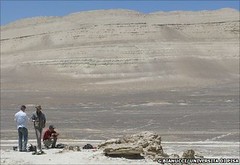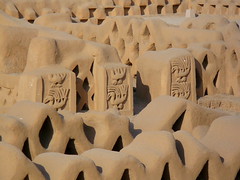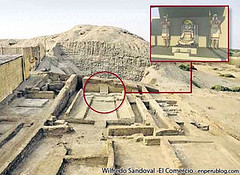The Sacred City of Caral-Supe (Peru), the oldest centre of civilization in the Americas, was inscribed on UNESCO’s World Heritage List by the World Heritage Committee, chaired by María Jesús San Segundo, the Ambassador and Permanent Delegate of Spain to UNESCO.
Category: "History"
Application submitted to destroy ancient Chan Chan ruins
It almost defies belief that a mining company would summit an application to mine for iron ore in the ruins of the capital of the once powerful Chimu kingdom. The sprawling archaeological zone of Chan Chan is a UNESCO World Heritage site and one of the largest adobe constructions on earth.
Thankfully, Peru’s geological authority in charge of granting permission (INGEMMET) has no plans to approve this particular application.
Kusikancha – Inca Cusco revealed
Much of the ancient layout of Cusco has been lost beneath its more recent colonial buildings. Just a few of the narrow streets with central drainage channels remain and almost nothing can be seen of the city layout known as the “chanchas”. That was, until now.
Pre-Inca tomb found at Salapunku, Machu Picchu reserve
Archaeologists from the National Institute of Culture (INC) have found a pre-Inca tomb at the Salapunku archaeological site located in the protected area of Machu Picchu.
The Salapunku site, located above the railway line than today takes visitors to the ruins of Machu Picchu, is home to a bridges, an aqueducts and now pre-Inca tombs.
The discovery was made in the area known as Zone III and the tombs were located in a sheltered part of a rock face. The burial is thought to be of the Quillke culture that lived here before the Incas, as Quillke pottery was found alongside the bones, as well as fragments of obsidian.
Ancient temple wall discovered, shaped like Andean chakana
Ventarrón, a 4000 year old ceremonial site with spectacular murals painted by ancient peoples who lived during the dawn of civilisation, has given up another stunning prize.
Chucuito, Callao
Where old Callao ends and La Punta begins is Chucuito, a little barrio on the rocky beaches to the side of Peru’s, main port. Originally settled by Italian immigrants as recently as the late 1800s, it soon merged seamlessly into its increasing urban surroundings.
Al Jazeera’s take on Lima Street Food [Featured]
With a focus primarily on what Andean communities have contributed to this city’s famous cuisine, Al Jazeera takes a look at street food in Lima.
La Punta del Callao
Jutting out into the Pacific from the old port city of Callao is La Punta. Despite being attached to the noisy and bustling metropolis that is Lima and Callao, La Punta remains tranquil and pleasant, not unlike a small town in itself. Deeply connected to the sea and sea-faring, this is where private owners of yachts tie-up, where boating clubs reside and where the Peruvian Navy has its naval school. Home to Callao’s middle-class, its streets are attractive and tidy, lined with the mansions of the countries Republican period.
The ‘Peruvian vampire’ from East Lancashire [Featured]
Sarah Roberts, an East Lancashire woman who died 96 years ago in Peru, is one of the most iconic cult figures in the South American country. According to Peruvian legend, she had to be buried there as nowhere else in the world would take the casket of a woman believed to be one of the three brides of Dracula. But historians in East Lancashire said Sarah was ‘just a cotton weaver’ and that there was no substance whatsoever in the Peruvian myth.
Colonial Callao
Starting life as a rocky bay that was the nearest natural port to Pizarro’s capital of Los Reyes, El Callao soon became the most important port in the Spanish colonies. It has witnessed colonial splendour, pirate attacks, disastrous tsunamis, battles, republican splendour and economic collapse. Each of these events have left a mark on the city and the chalacos that live there, many of these marks visible to this day.
Huarco temple complex of Vilcahuasi
I couldn’t believe what I was seeing when I finally looked out around me from atop the huge mound of sand I had just climbed. What I was standing on was clearly the remains of an ancient pyramid, and next to it was another and another and another after that. I counted twelve in total.
The first Peruvian car
Such is Peruvian ingenuity that this was the first nation in South America to produce high-quality automobiles. World-beating ones at that. But as great as Peruvian creativity… is a lack Peruvian self esteem. What could have been the start of a major Peruvian industry was snuffed out by Peruvians themselves, who then, as now, see everything from abroad as better, whether it really is or not.






![The Afro-Peruvian Struggle [Featured]](http://farm2.static.flickr.com/1036/554992984_766219de66_m.jpg)



